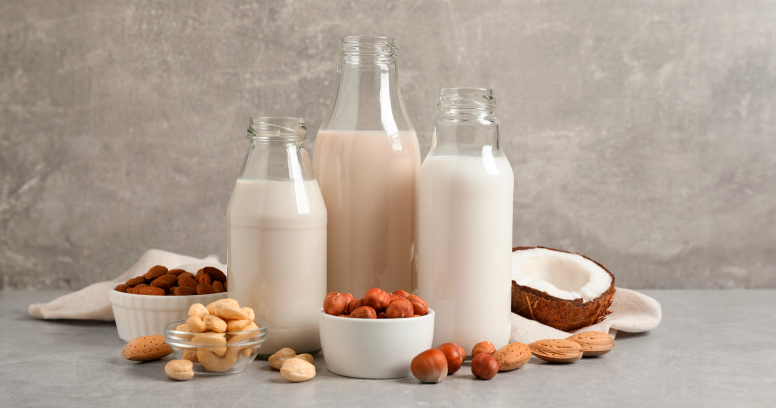The truth about cow’s milk

What’s your go-to drink? If you said milk, you’re not alone. Cow’s milk is a popular drink for most North Americans and Europeans. In most households, you’ll probably find a jug, carton, or — if you’re Canadian — bag of cow’s milk in the fridge.

However, in recent years, some people have wondered: Is milk actually healthy? Sure, we’ve been drinking it for 10,000 years or more … but is it something that works for us in the 21st century?[1]
In this article, we’ll explore cow’s milk facts and fiction — and help you decide if it’s a good choice for you.
Curious about how that glass of milk at dinner or your other favorite drinks stack up nutritionally? Dive into Simple’s Nutrition Score tracker and see how your choices measure up. Get started today by taking our Simple quiz.
Milk’s nutritional makeup
With 16 essential nutrients and minerals, milk is a nutritional powerhouse.[2,3,4] It’s an excellent source of:
- Calcium: One cup contains 30% of your daily calcium requirements, and it does more than build strong bones. Calcium helps regulate muscle contraction and control your blood pressure.[5] Milk also contains some proteins that help us absorb the calcium that milk contains.[2]
- Vitamin D: Vitamin D is a critical nutrient with many roles in the body. In most countries, fortifying cow’s milk by adding vitamin D is mandatory since it helps you absorb calcium.[6]
- Phosphorus: This mineral helps you form bones and teeth.[7]
- Protein: Protein is your body’s main building block. It supports a robust immune system, helps build and maintain muscle mass, and has dozens of other functions.[8,9]
- B vitamins: There are many B vitamins in milk.[3] B vitamins like B1, B2, and B12 help maintain your overall well-being and have a beneficial impact on your brain function, energy, and metabolism.[10,11,12,13,14]
- Other minerals: Cow’s milk also contains traces of other minerals, like magnesium, zinc, and selenium, which are also important for health.[3]
Milk’s health benefits

Milk and bone health
Milk is considered a top food for developing strong bones and teeth, which is why it’s such a popular kid’s beverage. Calcium gets the credit for dense bone mass. Still, you can also thank milk’s many other nutrients: vitamin D, phosphorus, protein, vitamin K2, and potassium, to name a few!
Drinking milk can lower your risk of osteoporosis, a bone disease where bones become brittle and less dense, which increases the risk of fractures and frailty, especially as we age.[4,15,16]
While many things contribute to osteoporosis, lack of calcium is one key risk factor. Although your bone mass peaks by the age of 30, we all benefit from getting enough calcium throughout our lives.[17]
Interestingly, there’s emerging evidence that other factors in cow’s milk may also support bone health, such as the carbohydrates that feed our helpful gut bacteria.[15]
If you’re over 30 and have never been a milk drinker, don’t fret. You can still minimize bone loss and fracture risk well into your older years. Be mindful of your calcium intake, and remember that milk isn’t the only source, but it’s a convenient and affordable option.
Other sources of calcium
If you’d like to get your calcium from a source other than milk, try:
- almonds
- soy milk
- tofu
- dried figs
- broccoli rabe
- edamame
- kale
- sweet potatoes
If you’re between 19 and 50, try to get 1,000 mg of calcium daily. And if you’re female and over 50 or male and over 70, increase it to 1,200 mg.[5] For reference, one cup of milk has 300 mg of calcium.
Quick tip: For bone health, include lots of sources of calcium in your diet.
Milk and heart health
Milk may support cardiovascular health, in part by potentially helping lower blood pressure, a significant factor in heart disease prevention.
Why? The potassium in milk may play a role.[18]
Potassium, a vital mineral, helps maintain heart health. It counteracts the harmful effects of excessive sodium (salt) intake by regulating blood pressure. A diet rich in potassium helps keep blood pressure in check, reducing the risk of cardiovascular diseases.[19]
Milk is a good source of potassium, contributing significantly to our daily potassium intake. This means incorporating milk into your daily nutrition can be a heart-healthy choice.
That said, when choosing milk, take a look at the overall fat content. While whole milk provides essential nutrients, it’s higher in saturated fat. Diets high in saturated fat are linked to a higher risk of heart disease.
So, opting for lower-fat milk choices can be a heart-smart decision, as it maintains the goodness of milk’s nutrients without the added saturated fat.[20] So, whether you choose skim, 1%, or 2% milk, you’re still reaping the benefits of milk’s nutrient profile while supporting your cardiovascular well-being.
Quick tip: Consider opting for lower-fat milk to enjoy the potential benefits while lowering overall risk.

Milk, muscle growth, and recovery
When we work out hard, we damage our muscles and connective tissues — just a tiny bit. This isn’t bad; in fact, it’s what helps us get stronger. When our body repairs this “microdamage,” it needs plenty of protein to rebuild those tissues.
Even if you’re not an athlete striving for peak performance, protein is a crucial part of recovery and repair in the body.[9]
(For instance, protein intake is also part of healthy aging, and a higher protein intake is linked to better physical performance and greater muscle strength in older adults.[21,22])
The term “anabolism” refers to the “building up” of tissues. The “anabolic window” is the period of a few hours after a workout when your muscles are sort of like sponges, looking to suck up the most nutrients for recovery and growth.[23,24]
Having some protein during this time may help improve recovery.
While you could just eat a regular meal — and that would be fine — milk is often the drink of choice after workouts, thanks to its nutrient profile.
Milk has a blend of proteins, including both whey and casein, making it a fantastic choice for muscle recovery. Whey protein is rapidly absorbed, initiating the muscle-building process, while casein provides a slower release of amino acids, ensuring a steady supply for longer-lasting repair and growth.
Quick tip: If you’re looking for a quick and easy post-workout protein boost, consider including some milk.
Weight management
While milk does contain calories, it also seems to help promote weight loss.
The protein and fat content in milk may help lower appetite, meaning people tend to eat less in the long term. Calcium may also play a role.[25,26]
When you feel full, you’re less likely to indulge in high-calorie, unhealthy snacks, which can ultimately help you in your weight management journey.
Milk is also more nutritious than other calorie-containing drinks like soda or alcohol.
Quick tip: Experiment with lower-fat milk and see if you notice whether it helps you feel more full.
Milk types

Raw vs. pasteurized
Raw milk comes directly from the cow. While advocates believe it’s “more nutritious,” health agencies like the US Centers for Disease Control and Prevention have a different take: raw milk “can pose severe health risks. Milk isn’t pasteurized to kill disease-causing germs.”
Before modern food processing, including heat-based pasteurization that killed harmful bacteria like E.coli, listeria, and salmonella, outbreaks of milk-borne diseases were common — and sometimes deadly.[27] Even today, outbreaks from raw milk continue to hospitalize and harm people, especially children and those who are immunocompromised.[28,29,30]
Some countries, like Spain, Poland, and Norway, have banned raw milk sales altogether. In the US, raw milk is illegal in 20 states.[31]
Depending on where you are in the world, follow local public health regulations and guidelines for consuming milk. Pregnant, older, or immunocompromised people and young children should avoid raw milk and instead opt for pasteurized.
Choose pasteurized milk, which is still highly nutritious but also safe to drink.
Milk fat percentages
When you visit the dairy aisle, you’ll see 3.25% (whole milk), 2% (reduced-fat milk), 1% (low-fat milk), and 0% (skim milk). These percentages refer to the amount of fat in the milk product. Full fat and 2% will taste creamier and more satiating, plus you’ll absorb more fat-soluble vitamins. Skim milk will taste lighter.
But remember, dietary fat doesn’t make you fat, and milk contains fat for a reason. Many of the milk vitamins are fat-soluble, which means you need the fat in milk to absorb the vitamins. Cow’s milk also has a special type of fatty acid, conjugated linoleic acid (CLA). This comes from microbes in ruminant animals’ stomachs and may have additional health benefits.[3,15]
Recent studies show that full-fat milk and other dairy products may actually be good for your cardiovascular health rather than harmful.[32]
So:
- Lower-fat milk will be lower in calories.
- Higher-fat milk may be more satiating and help you absorb fat-soluble vitamins more effectively.

Possible downsides of cow’s milk
Lactose intolerance
Lactose is a type of sugar found in milk. We need an enzyme called lactase to break it down properly during digestion. Most children have this, but many of us lose lactase persistence — the ability to secrete this enzyme — as adults.
Lactase persistence is genetic, and it varies widely across the world. If your ancestors were originally from dairy-farming populations, like northern Europeans, some regions in Africa, or the Middle East, you might have kept your dairy-digesting abilities. But if your ancestors were from other parts of the world, you might be out of luck![1,33]
Luckily, lactose intolerance isn’t life-threatening, just inconvenient. If you don’t produce lactase, milk and other dairy products can cause uncomfortable digestive symptoms like gas, bloating, and diarrhea.
You can have a hydrogen breath test or stool acidity test to see if you’re lactose intolerant, or you can monitor your symptoms. If it hurts, don’t drink it!
Opt for lactose-free milk instead, which won’t trigger your symptoms.
Milk protein allergy
A milk protein allergy is a more severe condition where drinking milk can trigger an abnormal immune response. Casein and whey are the two main proteins in cow’s milk that cause allergic reactions. Signs of a milk protein allergy can vary.
If you have hives, difficulty breathing, swelling in your mouth, vomiting, or itching after drinking milk, talk to your doctor about potential testing and avoid milk.[34,35]
Dairy sensitivity
Some people don’t have lactose intolerance or an allergy per se but are still sensitive to some of the components of milk, such as particular milk proteins. They may find that they have particular symptoms, such as a rash, constipation, or stuffy nose, when consuming cow’s milk.[34,35]
In this case, they might be able to switch to other animal milks (such as goat or sheep milk) or choose plant-based milk instead.[36]
Milk alternatives
If you don’t do dairy, there are a variety of popular milk alternatives that provide some of the vitamins and minerals in cow’s milk in varying amounts:
- Almond milk: Fortified almond milk contains calcium, vitamin D, and B vitamins, but it’s not a significant protein source.
- Oat milk: 1 cup = 4 g protein, calcium, vitamin D, B vitamins
- Pea milk: 1 cup = 8 g protein, calcium, vitamin D, B vitamins
- Soy milk: 1 cup = 8 g protein, calcium, vitamin D, B vitamins
*Note: Double-check the nutrition facts to ensure your milk alternative is fortified.
For more on this, check out our article “Which Milk is the Healthiest for You?”
Frequently asked questions about milk
If you can digest and tolerate it well, then yes, milk is an excellent source of essential nutrients such as calcium, high-quality protein, potassium, and vitamins like D and B12. These nutrients promote strong bones, muscle repair, and overall well-being. Milk can be an important part of a balanced diet.[20]
The recommended daily intake varies, but consuming 1–3 servings (e.g., 1 cup of milk per serving) is generally recommended.[37] It’s best to consult with a healthcare professional or nutritionist to determine the right amount for your specific needs.Wondering how to optimize your nutrition and wellness? Take our Simple quiz for a personalized plan tailored to your needs and kickstart a healthier you!

- Bleasdale M, Richter KK, Janzen A, Brown S, Scott A, Zech J, et al. Ancient proteins provide evidence of dairy consumption in eastern Africa. Nat Commun. 2021 Jan 27;12(1):632.
- Woźniak D, Cichy W, Dobrzyńska M, Przysławski J, Drzymała-Czyż S. Reasonableness of enriching cow’s milk with vitamins and minerals. Foods. 2022 Apr 8;11(8).
- Pereira PC. Milk nutritional composition and its role in human health. Nutrition. 2014 Jun;30(6):619–27.
- Scholz-Ahrens KE, Ahrens F, Barth CA. Nutritional and health attributes of milk and milk imitations. Eur J Nutr. 2020 Feb;59(1):19–34.
- National Institute of Health Nutrition Factsheets: Calcium [Internet]. [cited 2023 Sep 22]. Available from: https://ods.od.nih.gov/factsheets/Calcium-HealthProfessional/
- National Institute of Health Nutrition Factsheets: Vitamin D [Internet]. [cited 2023 Sep 22]. Available from: https://ods.od.nih.gov/factsheets/VitaminD-HealthProfessional/
- National Institute of Health Nutrition Factsheets: Phosphorus [Internet]. [cited 2023 Sep 22]. Available from: https://ods.od.nih.gov/factsheets/Phosphorus-HealthProfessional/
- Nunes EA, Colenso-Semple L, McKellar SR, Yau T, Ali MU, Fitzpatrick-Lewis D, et al. Systematic review and meta-analysis of protein intake to support muscle mass and function in healthy adults. J Cachexia Sarcopenia Muscle. 2022 Apr;13(2):795–810.
- Jäger R, Kerksick CM, Campbell BI, Cribb PJ, Wells SD, Skwiat TM, et al. International Society of Sports Nutrition Position Stand: Protein and exercise. J Int Soc Sports Nutr. 2017 Jun 20;14:20.
- National Institute of Health Nutrition Factsheets: Thiamin [Internet]. [cited 2023 Sep 22]. Available from: https://ods.od.nih.gov/factsheets/Thiamin-HealthProfessional/
- National Institute of Health Nutrition Factsheets: Riboflavin [Internet]. [cited 2023 Sep 22]. Available from: https://ods.od.nih.gov/factsheets/Riboflavin-HealthProfessional/
- Malouf R, Grimley Evans J. The effect of vitamin B6 on cognition. Cochrane Database Syst Rev. 2003;(4):CD004393.
- Hunt A, Harrington D, Robinson S. Vitamin B12 deficiency. BMJ. 2014 Sep 4;349:g5226.
- National Institute of Health Nutrition Factsheets: Vitamin B12 [Internet]. [cited 2023 Sep 22]. Available from: https://ods.od.nih.gov/factsheets/VitaminB12-HealthProfessional/
- Ilesanmi-Oyelere BL, Kruger MC. The role of milk components, pro-, pre-, and synbiotic foods in calcium absorption and bone health maintenance. Front Nutr. 2020 Sep 23;7:578702.
- Varenna M, Manara M, Galli L, Binelli L, Zucchi F, Sinigaglia L. The association between osteoporosis and hypertension: the role of a low dairy intake. Calcif Tissue Int. 2013 Jul;93(1):86–92.
- Bone health: Tips to keep your bones healthy [Internet]. Mayo Clinic. 2022 [cited 2023 Sep 22]. Available from: https://www.mayoclinic.org/healthy-lifestyle/adult-health/in-depth/bone-health/art-20045060
- Soedamah-Muthu SS, Verberne LDM, Ding EL, Engberink MF, Geleijnse JM. Dairy consumption and incidence of hypertension: a dose-response meta-analysis of prospective cohort studies. Hypertension. 2012 Nov;60(5):1131–7.
- Aburto NJ, Hanson S, Gutierrez H, Hooper L, Elliott P, Cappuccio FP. Effect of increased potassium intake on cardiovascular risk factors and disease: Systematic review and meta-analyses. BMJ. 2013 Apr 3;346:f1378.
- Thorning TK, Raben A, Tholstrup T, Soedamah-Muthu SS, Givens I, Astrup A. Milk and dairy products: good or bad for human health? An assessment of the totality of scientific evidence. Food Nutr Res. 2016 Nov 22;60:32527.
- Coelho-Júnior HJ, Calvani R, Tosato M, Landi F, Picca A, Marzetti E. Protein intake and physical function in older adults: A systematic review and meta-analysis. Ageing Res Rev. 2022 Nov;81:101731.
- Hanach NI, McCullough F, Avery A. The impact of dairy protein intake on muscle mass, muscle strength, and physical performance in middle-aged to older adults with or without existing sarcopenia: A systematic review and meta-analysis. Adv Nutr. 2019 Jan 1;10(1):59–69.
- Aragon AA, Schoenfeld BJ. Nutrient timing revisited: Is there a post-exercise anabolic window? J Int Soc Sports Nutr. 2013 Jan 29;10(1):5.
- Schoenfeld BJ, Aragon AA. Is There a Postworkout Anabolic Window of opportunity for nutrient consumption? Clearing up controversies. J Orthop Sports Phys Ther. 2018 Dec;48(12):911–4.
- Zemel MB, Miller SL. Dietary calcium and dairy modulation of adiposity and obesity risk. Nutr Rev. 2004 Apr;62(4):125–31.
- Dennis EA, Flack KD, Davy BM. Beverage consumption and adult weight management: A review. Eat Behav. 2009 Dec;10(4):237–46.
- Adetunji SA, Ramirez G, Ficht AR, Perez L, Foster MJ, Arenas-Gamboa AM. Building the evidence base for the prevention of raw milk-acquired brucellosis: A systematic review. Front Public Health. 2020 Mar 13;8:76.
- Sebastianski M, Bridger NA, Featherstone RM, Robinson JL. Disease outbreaks linked to pasteurized and unpasteurized dairy products in Canada and the United States: A systematic review. Can J Public Health. 2022 Aug;113(4):569–78.
- Outbreak Studies [Internet]. 2023 [cited 2023 Sep 22]. Available from: https://www.cdc.gov/foodsafety/rawmilk/rawmilk-outbreaks.html
- Whitehead J, Lake B. Recent trends in unpasteurized fluid milk outbreaks, legalization, and consumption in the United States. PLoS Curr. 2018 Sep 13;10.
- Legal Status of the Sale of Raw Milk and Outbreaks* Linked to Raw Milk, by State, 2013–2018 [Internet]. 2022 [cited 2023 Sep 22]. Available from: https://www.cdc.gov/foodsafety/rawmilk/nonpasteurized-outbreaks-maps.html
- de Oliveira Otto MC, Lemaitre RN, Song X, King IB, Siscovick DS, Mozaffarian D. Serial measures of circulating biomarkers of dairy fat and total and cause-specific mortality in older adults: The Cardiovascular Health Study. Am J Clin Nutr. 2018 Sep 1;108(3):476–84.
- Swallow DM. Genetics of lactase persistence and lactose intolerance. Annu Rev Genet. 2003;37:197–219.
- Flom JD, Sicherer SH. Epidemiology of cow’s milk allergy. Nutrients. 2019 May 10;11(5).
- Tedner SG, Asarnoj A, Thulin H, Westman M, Konradsen JR, Nilsson C. Food allergy and hypersensitivity reactions in children and adults: A review. J Intern Med. 2022 Mar;291(3):283–302.
- Marangoni F, Pellegrino L, Verduci E, Ghiselli A, Bernabei R, Calvani R, et al. Cow’s milk consumption and health: A health professional’s guide. J Am Coll Nutr. 2019 Mar-Apr;38(3):197–208.
- USDA MyPlate Dairy Group – one of the five food groups [Internet]. [cited 2023 Dec 6]. Available from: https://www.myplate.gov/eat-healthy/dairy
